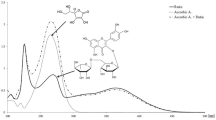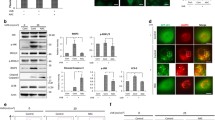Abstract
In human skin tissue nitrite is found at relatively high concentrations and represents the main source for cutaneous non-enzymatic nitric oxide (NO) formation during UVA exposure due to photolytical decomposition. Since NO has been repeatedly shown to act pro- as well as anti-apoptotic we here studied the effects of UVA irradiation on human keratinocytes in the presence of nitrite. We show that UVA-induced nitrite photodecomposition effectively inactivated caspase activity. In parallel, we observed in human skin keratinocytes, UVA-irradiated in the presence of nitrite, a proteolytic processing of apoptosis-inducing factor (AIF) followed by translocation from the mitochondrion into the nucleus. This translocation resulted in a characteristic apoptotic nuclear phenotype, which differs from the known nuclear phenotype of caspase-mediated chromatin condensation and apoptotic body formation. Interestingly both, AIF translocation and AIF-induced nuclear phenotype changes can be inhibited by NO scavengers, demonstrating the distinct role of nitrite-derived NO in the observed processes. This mode of UVA-induced apoptosis is AIF-dependent and NO-mediated and strongly depends on the presence of nitrite, abundantly present in skin tissue. Thus, photolysis of nitrite in the skin appears to represent an important backup mechanism, which ensures removal of UVA-damaged cells even in the absence of caspase activation.








Similar content being viewed by others
References
Berneburg M, Gattermann N, Stege H et al (1997) Chronically ultraviolet-exposed human skin shows a higher mutation frequency of mitochondrial DNA as compared to unexposed skin and the hematopoietic system. Photochem Photobiol 66:271–275
Scharffetter-Kochanek K, Wlaschek M, Brenneisen P, Schauen M, Blaudschun R, Wenk J (1997) UV-induced reactive oxygen species in photocarcinogenesis and photoaging. Biol Chem 378:1247–1257
Weller R (2003) Nitric oxide: a key mediator in cutaneous physiology. Clin Exp Dermatol 28:511–514
Weller R (1997) Nitric oxide—a newly discovered chemical transmitter in human skin. Br J Dermatol 137:665–672
Furchgott RF (1955) The pharmacology of vascular smooth muscle. Pharmacol Rev 7:183–265
Wood PDMB, Redmond RW (1996) The mechanism of photochemical release of nitric oxide from S-nitrosoglutathione. Photochem Photobiol 64:518–524
Paunel AN, Dejam A, Thelen S et al (2005) Enzyme-independent nitric oxide formation during UVA challenge of human skin: characterization, molecular sources, and mechanisms. Free Radic Biol Med 38:606–615
Suschek CV, Briviba K, Bruch-Gerharz D, Sies H, Kroncke KD, Kolb-Bachofen V (2001) Even after UVA-exposure will nitric oxide protect cells from reactive oxygen intermediate-mediated apoptosis and necrosis. Cell Death Differ 8:515–527
Suschek CV, Schroeder P, Aust O et al (2003) The presence of nitrite during UVA irradiation protects from apoptosis. Faseb J 17:2342–2344
Suschek CV, Krischel V, Bruch-Gerharz D et al (1999) Nitric oxide fully protects against UVA-induced apoptosis in tight correlation with Bcl-2 up-regulation. J Biol Chem 274:6130–6137
Mowbray M, McLintock S, Weerakoon R et al (2009) Enzyme-independent NO stores in human skin: quantification and influence of UV radiation. J Invest Dermatol 129:834–842
Dimmeler S, Haendeler J, Nehls M, Zeiher AM (1997) Suppression of apoptosis by nitric oxide via inhibition of interleukin-1beta-converting enzyme (ICE)-like and cysteine protease protein (CPP)-32-like proteases. J Exp Med 185:601–607
Rossig L, Fichtlscherer B, Breitschopf K et al (1999) Nitric oxide inhibits caspase-3 by S-nitrosation in vivo. J Biol Chem 274:6823–6826
Chiodino C, Cesinaro AM, Ottani D et al (1999) Communication: expression of the novel inhibitor of apoptosis survivin in normal and neoplastic skin. J Invest Dermatol 113:415–418
Grossman D, McNiff JM, Li F, Altieri DC (1999) Expression of the apoptosis inhibitor, survivin, in nonmelanoma skin cancer and gene targeting in a keratinocyte cell line. Lab Invest 79:1121–1126
Dimmeler S, Zeiher AM (1997) Nitric oxide and apoptosis: another paradigm for the double-edged role of nitric oxide. Nitric Oxide 1:275–281
Volbracht C, Chua BT, Ng CP, Bahr BA, Hong W, Li P (2005) The critical role of calpain versus caspase activation in excitotoxic injury induced by nitric oxide. J Neurochem 93:1280–1292
Baud O, Li J, Zhang Y, Neve RL, Volpe JJ, Rosenberg PA (2004) Nitric oxide-induced cell death in developing oligodendrocytes is associated with mitochondrial dysfunction and apoptosis-inducing factor translocation. Eur J Neurosci 20:1713–1726
Susin SA, Lorenzo HK, Zamzami N et al (1999) Molecular characterization of mitochondrial apoptosis-inducing factor. Nature 397:441–446
Zamzami N, Susin SA, Marchetti P et al (1996) Mitochondrial control of nuclear apoptosis. J Exp Med 183:1533–1544
Susin SA, Daugas E, Ravagnan L et al (2000) Two distinct pathways leading to nuclear apoptosis. J Exp Med 192:571–580
Mnaimneh S, Geffard M, Veyret B, Vincendeau P (1997) Albumin nitrosylated by activated macrophages possesses antiparasitic effects neutralized by anti-NO-acetylated-cysteine antibodies. J Immunol 158:308–314
Mnaimneh S, Geffard M, Veyret B, Vincendeau P (1999) Detection of nitrosylated epitopes in Trypanosoma brucei gambiense by polyclonal and monoclonal anti-conjugated-NO-cysteine antibodies. C R Acad Sci III 322:311–322
Feelisch M, Rassaf T, Mnaimneh S et al (2002) Concomitant S-, N-, and heme-nitros(yl)ation in biological tissues and fluids: implications for the fate of NO in vivo. Faseb J 16:1775–1785
Rassaf T, Bryan NS, Kelm M, Feelisch M (2002) Concomitant presence of N-nitroso and S-nitroso proteins in human plasma. Free Radic Biol Med 33:1590–1596
Yuan CQ, Li YN, Zhang XF (2004) Down-regulation of apoptosis-inducing factor protein by RNA interference inhibits UVA-induced cell death. Biochem Biophys Res Commun 317:1108–1113
Finnen MJ, Hennessy A, McLean S et al (2007) Topical application of acidified nitrite to the nail renders it antifungal and causes nitrosation of cysteine groups in the nail plate. Br J Dermatol 157:494–500
Mahotka C, Liebmann J, Wenzel M et al (2002) Differential subcellular localization of functionally divergent survivin splice variants. Cell Death Differ 9:1334–1342
Ambrosini G, Adida C, Altieri DC (1997) A novel anti-apoptosis gene, survivin, expressed in cancer and lymphoma. Nat Med 3:917–921
Mahotka C, Wenzel M, Springer E, Gabbert HE, Gerharz CD (1999) Survivin-deltaEx3 and survivin-2B: two novel splice variants of the apoptosis inhibitor survivin with different antiapoptotic properties. Cancer Res 59:6097–6102
Grossman D, Kim PJ, Blanc-Brude OP et al (2001) Transgenic expression of survivin in keratinocytes counteracts UVB-induced apoptosis and cooperates with loss of p53. J Clin Invest 108:991–999
Hinds MG, Norton RS, Vaux DL, Day CL (1999) Solution structure of a baculoviral inhibitor of apoptosis (IAP) repeat. Nat Struct Biol 6:648–651
Acknowledgements
Active caspase-3 was kindly provided by Prof. Dr. K. Schultze-Osthoff. This work was supported by a grant from the Deutsche Forschungsgemeinschaft (DFG), SFB 503, project A3.
Conflict of interest
The authors state no conflict of interest.
Author information
Authors and Affiliations
Corresponding author
Rights and permissions
About this article
Cite this article
Liebmann, J., Kolb-Bachofen, V., Mahotka, C. et al. Photolytically generated nitric oxide inhibits caspase activity and results in AIF-mediated cell death. J Mol Med 88, 279–287 (2010). https://doi.org/10.1007/s00109-009-0551-3
Received:
Revised:
Accepted:
Published:
Issue Date:
DOI: https://doi.org/10.1007/s00109-009-0551-3




